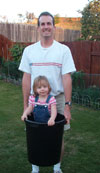 |
Citrus Growers Forum
This is the read-only version of the Citrus Growers Forum.
Breaking news: the Citrus Growers Forum is reborn from its ashes!
Citrus Growers v2.0
|
|
|
|
Formula For A Citrus Rooting Medium
|
| Author |
Message |
Millet
Citruholic


Joined: 13 Nov 2005
Posts: 6657
Location: Colorado
|
| Posted: Thu 21 Feb, 2008 2:32 am |
|
M. De La Quintinye - Chief Gardner for the French King Louis XIV developed this formula in the year 1730 as the "Royal" medium for rooting citrus cuttings.
Half mixture of the following sieved ingredients, well blended together:
Cow Dung
Powdered soil (Night Soil Only)
Pigeon droppings
Grape Marc *
Sheep manure
Composted sod grass
Coarse Fontainebleau sand
* Grape Marc = the grapes contained in the wine press and the residue, as skins and seeds, remaining after the juice is expressed.
------------------------------------------------------------------
If you try it let me know how it works out.
Millet |
|
| Back to top |
|
 |
dauben
Citruholic


Joined: 25 Nov 2006
Posts: 963
Location: Ramona, CA, Zone 9A
|
| Posted: Sun 24 Feb, 2008 4:02 am |
|
| Millet wrote: | M. De La Quintinye - Chief Gardner for the French King Louis XIV developed this formula in the year 1730 as the "Royal" medium for rooting citrus cuttings.
Half mixture of the following sieved ingredients, well blended together:
Cow Dung
Powdered soil (Night Soil Only)
Pigeon droppings
Grape Marc *
Sheep manure
Composted sod grass
Coarse Fontainebleau sand
* Grape Marc = the grapes contained in the wine press and the residue, as skins and seeds, remaining after the juice is expressed.
------------------------------------------------------------------
If you try it let me know how it works out.
Millet |
I wonder what the difference is between the sheep manure and the cow dung. Maybe a better balance to get the 5-1-3 relationship?
Phillip |
|
| Back to top |
|
 |
Millet
Citruholic


Joined: 13 Nov 2005
Posts: 6657
Location: Colorado
|
| Posted: Sun 24 Feb, 2008 6:02 pm |
|
Or the difference between day soil and night soil. - Millet |
|
| Back to top |
|
 |
fred
Citruholic

Joined: 16 Oct 2009
Posts: 134
|
| Posted: Thu 29 Oct, 2009 2:03 pm |
|
zz |
|
| Back to top |
|
 |
Skeeter
Moderator

Joined: 23 Jul 2006
Posts: 2218
Location: Pensacola, FL zone 9
|
| Posted: Thu 29 Oct, 2009 4:13 pm |
|
| dauben wrote: | | Millet wrote: | M. De La Quintinye - Chief Gardner for the French King Louis XIV developed this formula in the year 1730 as the "Royal" medium for rooting citrus cuttings.
Half mixture of the following sieved ingredients, well blended together:
Cow Dung
Powdered soil (Night Soil Only)
Pigeon droppings
Grape Marc *
Sheep manure
Composted sod grass
Coarse Fontainebleau sand
* Grape Marc = the grapes contained in the wine press and the residue, as skins and seeds, remaining after the juice is expressed.
------------------------------------------------------------------
If you try it let me know how it works out.
Millet |
I wonder what the difference is between the sheep manure and the cow dung. Maybe a better balance to get the 5-1-3 relationship?
Phillip |
It is a lot hgher in ammonia! Put a few sheep in a pen for a few days and the ammonia will burn your eyes!
_________________
Skeet
 |
|
| Back to top |
|
 |
JoeReal
Site Admin


Joined: 16 Nov 2005
Posts: 4726
Location: Davis, California
|
| Posted: Thu 29 Oct, 2009 4:25 pm |
|
Ever wondered why Sphagnum moss is THE MOST RECOMMENDED medium for air layering or for rooting?
Sphagnum moss has natural anti-fungal and anti-microbial properties. We've known this for ages, and now lately, they found it excellent for use in cleaning the water in swimming pools.
So I would always include sphagnum moss in rooting recipes. The latest news of rediscovering its uses confirms what we already know. Perhaps you can extrapolate this to clean out your spa and swimming pools for the natural water effect instead of chlorinated water. Tremendously many applications:
Source : http://www.msnbc.msn.com/id/33523558/ns/technology_and_science-science/
Forget pool boys! Moss keeps Minn. pools clean
Moss absorbs metals that encourage microbial growths, preventing biofilm
By Jessica Marshall
| Quote: | An unmistakable chlorine "pool smell" used to greet swimmers when they arrived the Oxford Community Center in St. Paul, Minn. "Now you don't smell it anymore," said Lynn Waldorf, aquatics director for the City of Saint Paul.
Meanwhile, at the city's outdoor pool, asthma sufferers reported less need for their inhalers last summer due to the reduction of the use of chlorine.
The secret to the pools' new reputation is the same thing that makes the state's northern lakes so clear: The pools now rely on sphagnum moss to clean the water.
The technology was developed by Creative Water Solutions, which is based out of Plymouth, Minn.
"People started stopping me and saying, 'What are you doing? The water is great,'" said Waldorf.
"We kind of make a little mini-bog off of the pool where the water passes through very slowly, and the moss conditions it and enhances it."
Sphagnum moss acts to inhibit the growth of microbes in the pool, says founder and CEO of Creative Water Solutions, David Knighton, who is also a surgeon.
He first became intrigued by sphagnum moss after reading about injured World War I soldiers whose wounds were packed with moss had greater survival than those whose wounds were packed with cotton.
"I knew from my years working with wound healing that it had to be antimicrobial," Knighton said.
His first interest was in medical applications, but Knighton, who is also a pilot, suspected that the moss might be helpful in conditioning water after flying northward over Minnesota's many lakes.
"As I went north, they got cleaner and cleaner," he said. "I wondered: 'Well, maybe it's the moss?'"
Frustrated that he could not keep his home spa chlorine levels stable, he tossed some sterilized moss in. "Within ten days, it cleaned up the spa."
The moss readily absorbs heavy metals, including iron, which often encourages microbial growth. Without any iron in the water, microbes can't grow.
But, more importantly, Knighton says, the moss also prevents the growth of biofilm, mats of bacteria that stick to pool surfaces and coat the inside of pipes, causing corrosion.
Biofilm absorbs the chlorine added to the pool, requiring increasing amounts of chlorine to maintain the required levels in the pool water.
As biofilm disappears from the pool with the use of moss, chlorine requirements decline.
"The moss allows chlorine to do its job," Knighton said. "The amount of chlorine you need decreases by 50 percent."
The Saint Paul outdoor pool saved around $35,000 in chemical costs this summer, Waldorf said. Meanwhile, revenue increased $100,000 as more swimmers visited the pool.
Knighton's business first targeted home spas (hot tubs) and pools. The Saint Paul pools were the first test of the system at a larger scale.
However, this is just the beginning of the applications Knighton has in mind. He is also targeting spa manufacturers, who fill their spas with water for testing in the factory.
Some of the water used in testing remains in the spas, where biofilm forms. This means home spas start out with a dose of biofilm before they're ever used.
Installing moss treatment in the factories could prevent this initial contamination, he said. A trial with one spa manufacturer reduced the initial biofilm load by 95 percent.
Knighton is also testing poultry watering systems to see if treating the water with moss changes the quality of the eggs and meat that result.
He has developed a system for treating home water supplies that has been installed on a trial basis in about 20 homes. "I've had moss in my house for two years, and people think I have bottled water."
Any industry that uses water could potentially benefit from moss treatment. Knighton wants to install his system on the cooling water at a power plant to test its effects on the water there.
For now, Knighton's products are filled with moss from New Zealand, where there is already a sphagnum moss harvesting industry in place. Moss is harvested by hand and flown out by helicopter to prevent damage to the bogs where the moss grows.
Knighton is currently lobbying Minnesota officials to develop regulations for sustainable moss harvest. "Northern Minnesota is the Saudi Arabia of moss," he said.
|
|
|
| Back to top |
|
 |
Roberto
Citruholic

Joined: 02 Jun 2009
Posts: 132
Location: Vienna/Austria
|
| Posted: Sun 08 Nov, 2009 8:24 pm |
|
Please can anybody tell what Fountainebleau sand is? Quartz?
In Austria some fertilizers are made from grape-seed.... |
|
| Back to top |
|
 |
Sylvain
Site Admin


Joined: 16 Nov 2007
Posts: 790
Location: Bergerac, France.
|
| Posted: Mon 09 Nov, 2009 5:31 am |
|
I think it is silica. |
|
| Back to top |
|
 |
citrange
Site Admin


Joined: 24 Nov 2005
Posts: 589
Location: UK - 15 miles west of London
|
| Posted: Mon 09 Nov, 2009 2:58 pm |
|
Night soil. Meaning #1: human excreta used as fertilizer
"Disposal has varied through time. In urban areas, usually slums, a night soil collector will arrive regularly, at varying time periods depending on the supply and demand for night soil collection. Usually this occurs during the night, giving the night soil its name."
For all you ever wanted to know about night soil:-
http://www.answers.com/topic/night-soil
It is in fact still an important subject in many parts of the world. |
|
| Back to top |
|
 |
ilyaC
Citruholic


Joined: 04 Sep 2009
Posts: 274
Location: France, 40km South of Paris
|
| Posted: Mon 09 Nov, 2009 4:50 pm |
|
| Roberto wrote: | Please can anybody tell what Fountainebleau sand is? Quartz?
In Austria some fertilizers are made from grape-seed.... |
Roberto,
I live on the edge of the forest of Fontainebleau. The soil there is very sandy coming from the weathering of sandstone rocks. The resulting sand is very fine quartz grain. The whole landscape in some places looks like Scandinavia with heath undercover.
_________________
Best regards,
Ilya |
|
| Back to top |
|
 |
| Informations |
 |
Our users have posted a total of 66068 messages
We have 3235 registered members on this websites
|
| Most users ever online was 70 on Tue 30 Oct, 2012 10:12 am |
Powered by phpBB © 2001, 2005 phpBB Group
|
|



















